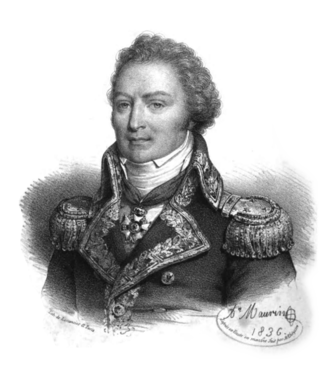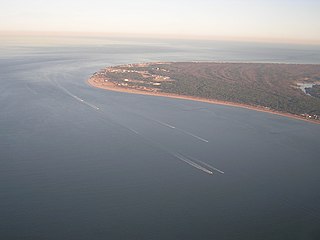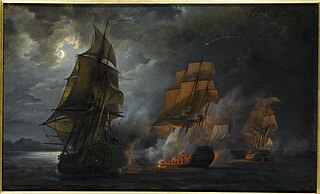
Jean-Baptiste Perrée was a French Navy officer and Rear-admiral.

The Redoutable was a Téméraire-class 74-gun ship of the line of the French Navy. She took part in the battles of the French Revolutionary Wars in the Brest squadron, served in the Caribbean in 1803, and duelled with HMS Victory during the Battle of Trafalgar, killing Vice Admiral Horatio Nelson during the action. She sank in the storm that followed the battle.

Louis-René Madelaine Le Vassor, comte de La Touche-Tréville was a French admiral. He fought in the American War of Independence and became a prominent figure of the French Revolutionary Wars and of the Napoleonic wars.

The Battle of Cape Henry was a naval battle in the American War of Independence which took place near the mouth of Chesapeake Bay on 16 March 1781 between a British squadron led by Vice Admiral Mariot Arbuthnot and a French fleet under Admiral Charles René Dominique Sochet, Chevalier Destouches. Destouches, based in Newport, Rhode Island, had sailed for the Chesapeake as part of a joint operation with the Continental Army to oppose the British army of Brigadier General Benedict Arnold that was active in Virginia.

HMS Ardent was a 64-gun third-rate ship of the line of the Royal Navy. She was built by contract at Blaydes Yard in Hull according to a design by Sir Thomas Slade, and launched on 13 August 1764 as the first ship of the Ardent-class. She had a somewhat turbulent career, being captured by the French in the action of 17 August 1779, and then re-captured by Britain in 1782.

Jean-Baptiste Philibert Willaumez was a French naval officer and nobleman who served during the French Revolutionary Wars and Napoleonic Wars. Willaumez joined the French Navy at the age of 14, and proved to be a competent sailor. Having risen to the rank of pilot, he started studying navigation, attracting the attention of his superiors up to Louis XVI himself. Willaumez eventually became an officer and served under Antoine Bruni d'Entrecasteaux in his expedition to rescue Jean-François de Galaup, comte de Lapérouse and explore the Indian Ocean and Oceania.

Surveillante was an Iphigénie-class 32-gun frigate of the French Navy. She took part in the Naval operations in the American Revolutionary War, where she became famous for her battle with HMS Quebec; in 1783, she brought the news that the war was over to America. She later took part in the French Revolutionary Wars, and was eventually scuttled during the Expédition d'Irlande after sustaining severe damage in a storm. The wreck was found in 1979 and is now a memorial.

Hermione was a 32-gun Concorde-class frigate of the French Navy. Designed for speed, she was one of the first ships of the French Navy to receive a copper sheathing. At the beginning of the Anglo-French War of 1778, she patrolled in the Bay of Biscay, escorting convoys and chasing privateers. She became famous when she ferried General La Fayette to the United States in 1780 in support of the rebels in the American Revolutionary War. She took an incidental role in the Battle of Cape Henry on 16 March 1781, and a major one in the action of 21 July 1781.

The action of 21 July 1781 was a naval skirmish off the harbour of Spanish River, Cape Breton, Nova Scotia, during the War of American Independence. Two light frigates of the French Navy, captained by La Pérouse and Latouche Tréville, engaged a convoy of 18 British ships and their Royal Navy escorts. The French captured one of the British escorts while the remainder of the British convoy escaped.

Admiral comte Pierre André de Suffren de Saint Tropez, bailli de Suffren, Château de Saint-Cannat) was a French Navy officer and admiral. Beginning his career during the War of the Austrian Succession, he fought in the Seven Years' War, where he was taken prisoner at the Battle of Lagos. Promoted to captain in 1772, he was one of the aids of Admiral d'Estaing during the Naval battles of the American Revolutionary War, notably taking part in the Siege of Savannah.

Hector was a 74-gun ship of the line of the French Navy, lead ship of her class. Hector was launched in 1755 and fought in the American Revolutionary War during which she captured two ships of the British Royal Navy on 14 August 1778. In 1782, the ship was captured by the Royal Navy at the Battle of the Saintes in 1782. Taken into service by the Royal Navy, the vessel was renamed HMS Hector. On 5 September 1782. HMS Hector fought two French frigates. Severely damaged during the battle, and by a hurricane that followed later in September, Hector sank on 4 October 1782.

Galathée was a 32-gun frigate of the French Navy, lead ship of her class.

The action of 28 June 1803 marked the opening shots of the Blockade of Saint-Domingue after the collapse of the Treaty of Amiens and the outbreak of the War of the Third Coalition in May 1803.

The French frigate Aigle was launched in 1780 as a privateer. The French Navy purchased her in 1782, but the British captured her that same year and took her into the Royal Navy as the 38-gun fifth rate HMS Aigle. During the French Revolutionary Wars she served primarily in the Mediterranean, where she was wrecked in 1798.
The action of 15 September 1782 was a naval action in the mouth of the Delaware Bay in which four Royal Naval vessels under the command of George Elphinstone pursued and attacked three French warships that included two frigates under the command of Comte de la Touche Tréville. The French 38-gun frigate Aigle was grounded and captured along with the Comte de la Touche.
The action of 7 June 1780 took place during the American War of Independence between the frigates Hermione and HMS Iris. The ships exchanged fire for one hour and a half before parting. The battle resumed in written form when James Hawker published his account of the battle in a newspaper, which Louis-René Levassor de Latouche Tréville contested heatedly.

Théobald-René, Comte de Kergariou-Locmaria was a French Navy officer and Royalist émigré.

Amazone was a 32-gun Iphigénie-class frigate of the French Navy. She was the second ship of the French Navy to receive a copper sheathing in 1778. She served in the War of American Independence under Captain Lapérouse, and later in the French Revolutionary Wars.

Éveillé was an Artésien-class 64-gun ship of the line of the French Navy, launched in 1772.

Triton was a 64-gun ship of the line of the French Navy designed by François Coulomb the Younger. She took part in the Seven Years' War and in the War of American Independence.

















